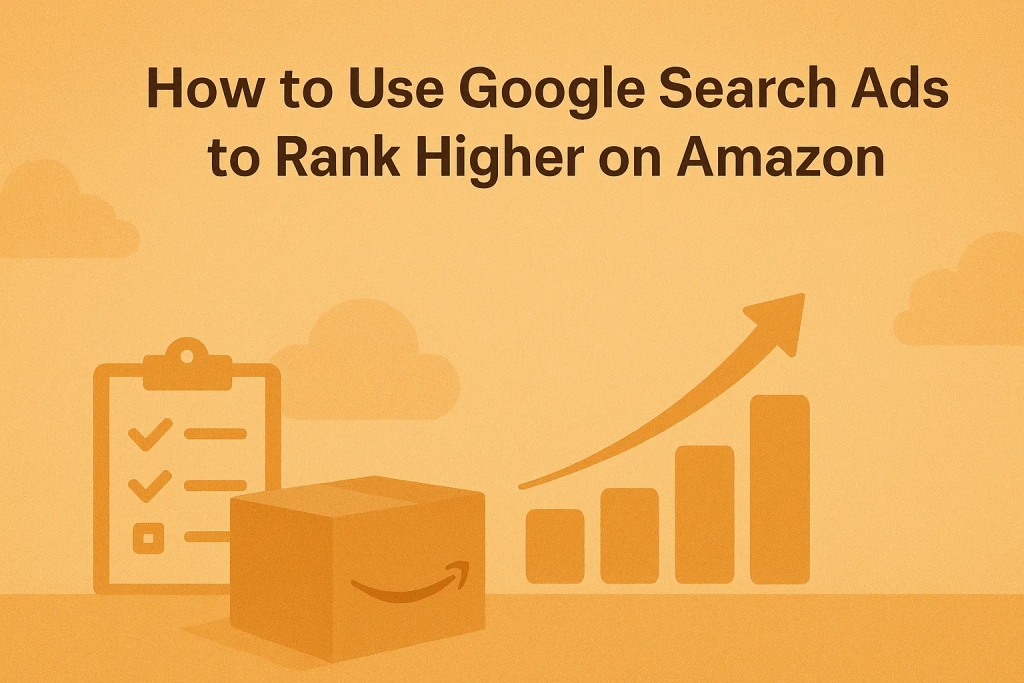
How to Use Google Search Ads to Rank Higher on Amazon
Hey Amazon sellers! Feeling like you’re working hard, but not seeing the results you deserve? Are you relying mostly on Amazon PPC and wondering if there’s a better way? I get it. I’ve been there. It’s easy to feel stuck in the Amazon ecosystem, but there’s a powerful tool that can help you break free: Google Ads.
Why Google Ads? Think Bigger Than Amazon
You might be thinking, “Google Ads for Amazon? Is that even a thing?” Trust me, it is. And it can be a game-changer. The truth is, limiting yourself to Amazon’s internal traffic is like only playing half the game. You’re missing out on a huge audience that’s already searching for products like yours.
Did you know that a large percentage of online shoppers start their search on Google? By focusing only on Amazon, you’re missing out on a HUGE number of potential clients!
Action Item: Think about where your ideal customers are actually starting their search. Are they always on Amazon, or are they using Google to find solutions?
Amazon’s Algorithm: What Makes External Traffic So Appealing?
So, why does Amazon care if you bring them traffic from Google? It all comes down to validation. When potential customers search for your product on Google, click your ad, and then choose to buy it on Amazon, that sends a strong signal to Amazon that your product is valuable and relevant.
Plus, you’re bringing new customers to their platform, and that’s a win-win for everyone. It’s like you’re doing Amazon a favor by expanding their reach.
Many people see a “halo effect” when they drive traffic from Google. It can help you boost your rankings across all your keywords, not just the ones you’re targeting.
Amazon’s Brand Referral Bonus: A Little Help From Your Friends
Here’s the best part: Amazon wants you to bring them traffic from Google, so they’re offering a little incentive! With the Brand Referral Bonus program, you can get up to 10% back on sales that come from external sources. Think of it as a discount on your advertising costs.
Action Item: If you haven’t already, sign up for the Brand Referral Bonus program. It’s a simple way to save money and boost your profits.
Setting Up Google Ads: Let’s Keep It Simple
Okay, let’s dive into the setup process. Google Ads might seem complicated at first, but I promise it’s not as scary as it looks. We’ll walk through the key steps together.
- Create a Google Ads Account: Head over to ads.google.com and sign up for an account.
- Choose a Campaign Goal: Select “Sales” as your campaign goal. We’re here to drive revenue, right?
- Select a Campaign Type: Choose “Search” as your campaign type. We want to target people who are actively searching for solutions.
- Set Your Budget: Start with a manageable budget. You can always adjust it later as you see results.
- Choose Your Targeting: Target the countries where you sell your products on Amazon.
- Write Your Ads: We’ll cover ad copy in the next section.
Campaign Structure: A Place for Everything, and Everything in Its Place
Think of your Google Ads campaigns like a well-organized system. You want to group your products and keywords in a way that makes sense.
For example, if you’re selling “Organic Coffee Beans,” you might structure your campaign like this:
- Campaign: “Organic Coffee Beans” – This is the main container for all your ads.
- Ad Group 1: “Best Organic Coffee Beans” – Target people who are ready to buy with keywords like
best organic coffee beans,buy organic coffee beans,organic coffee beans online. - Ad Group 2: “Fair Trade Coffee Beans” – Target people who care about ethical sourcing with keywords like
fair trade organic coffee beans,ethically sourced coffee,sustainable coffee brands. - Ad Group 3: “Coffee Subscription” – Target people who want a regular supply of coffee with keywords like
coffee subscription box,organic coffee delivery,monthly coffee subscription.
The key is to target the right keywords. Use the Google Keyword Planner to find out what people are actually searching for.
Action Item: Grab a pen and paper and brainstorm a list of keywords for your Amazon products. What words and phrases would you use if you were looking to buy your product?
Keyword Tip: Adding “Amazon” to the Mix
Here’s a simple but effective trick: Add “Amazon” to some of your keywords. For example, instead of just “running shoes,” try targeting “running shoes Amazon.” This helps you reach people who are specifically looking to buy on Amazon.
By adding this qualifier, you will target a more engaged customer, and reduce the costs of your campaign!
Action Item: Experiment with adding “Amazon” to a few of your keywords and see how it affects your results.
Ad Copy That Works: Focus on Benefits, Not Just Features
Your ad copy is your first impression. Make it count! Focus on the benefits of your product and how it can solve your customers’ problems. Here’s a simple template to get you started:
- Headline 1: “Premium [Product Name] – Shop Now!”
- Headline 2: “[USP – Unique Selling Proposition] – Free Shipping on Amazon” (Example: “Fair Trade & Organic – Free Shipping on Amazon”)
- Headline 3: “Limited-Time Offer – Don’t Miss Out!”
- Description 1: “[Key Feature 1] + [Key Feature 2] – Solve Your [Problem]” (Example: “Smooth Taste + Rich Aroma – Start Your Day Right”)
- Description 2: “Available on Amazon. Satisfaction Guaranteed.”
Action Item: Write a few different ad variations for each of your target keywords. Try different headlines and descriptions to see what resonates best with your audience.
Tracking: Know What’s Working (and What’s Not)
Tracking your results is essential. Otherwise, you’re just guessing. Amazon Attribution is a powerful tool that tells you exactly which keywords and ads are driving sales on Amazon.
- Create Amazon Attribution Links: In Amazon Seller Central, go to “Advertising” and then “Amazon Attribution.”
- Create a New Campaign: Set up a new campaign for your Google Ads traffic.
- Generate Tracking Links: Create unique tracking links for each of your Google Ads campaigns and ad groups.
- Use the Links in Your Google Ads: Replace your Amazon product URLs with your Amazon Attribution tracking links.
Action Item: Set up Amazon Attribution tracking links for all of your Google Ads campaigns. It might take a little time, but it’s worth the effort.
Direct Linking vs. Landing Pages: Which Path Should You Choose?
Should you send people directly to your Amazon listing, or should you use a landing page in between? It depends on your goals.
- Direct Linking: This is the simplest approach. You’re sending people straight to your Amazon product page where they can buy right away.
- Landing Pages: This is a more advanced strategy. It allows you to collect email addresses, build your brand, and pre-qualify your leads before sending them to Amazon.
Action Item: Think about your long-term strategy. Are you focused on building a brand, or are you primarily concerned with driving sales?
Budget Tips: Start Small, Scale Smart
How much should you spend on Google Ads? It depends on your budget and your goals. But here’s a general guideline:
- New Product Launch: Start with a small daily budget to test the waters and see what works.
- Established Product: If you’re already running Amazon PPC, consider allocating a portion of that budget to Google Ads.
The key is to be patient and track your results. Don’t expect to see a huge return overnight.
Action Item: Review your current advertising budget and see how much you can realistically allocate to Google Ads.
Google Ads vs. Amazon PPC: A Powerful Combination
Amazon PPC is a great tool for reaching customers who are already on Amazon, but Google Ads can help you reach a much wider audience. In some cases, Google Ads can also be more cost-effective.
By combining Google Ads with Amazon PPC, you can create a powerful marketing strategy that reaches more customers and drives more sales.
Action Item: Research the cost-per-click for your keywords on both Google Ads and Amazon PPC and compare the results.
Real-World Success: Seeing Is Believing
Want to see some real-world examples of Amazon sellers using Google Ads to boost their sales? There are plenty of success stories out there. Look for case studies to see what’s working for other businesses in your niche.
Action Item: Take some time to research case studies of Amazon sellers who are using Google Ads.
Take Action: Start Today!
Okay, Amazon sellers, it’s time to take action. Google Ads can be a valuable tool for growing your business, but it’s not going to happen overnight.
Start small, test different strategies, and track your results. You’ve got this!
Action Item: Choose one thing from this article and implement it today.
Need a Hand?
If you’re feeling a bit overwhelmed, don’t hesitate to reach out. My team at Texonica.com is here to help you create a Google Ads strategy that works for your business. We’re passionate about helping Amazon sellers succeed.
Let me know what you think of this tone! I tried to balance the directness with a more encouraging and supportive voice.
About the Author:
Kamil Kluziak
Founder and CEO
